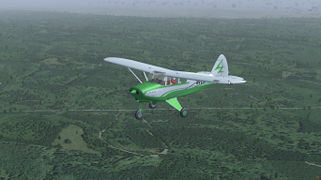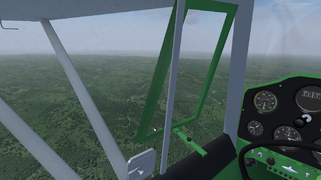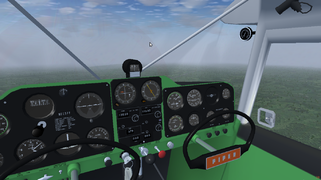Piper PA-22 Tri-Pacer
 | |
|---|---|
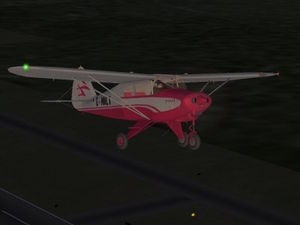 | |
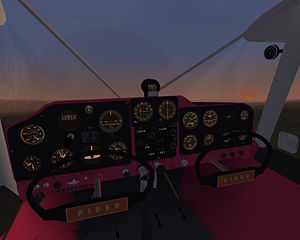 The cockpit of the Tri-Pacer. | |
| Type | Civil utility aircraft, Light aircraft |
| Configuration | High wing aircraft |
| Propulsion | Piston aircraft, Single-engine aircraft |
| Manufacturer | Piper |
| Author(s) |
|
| FDM | YASim |
| --aircraft= | pa22-160 |
| Status | Beta |
| Development | |
| Website |
|
| Repository |
|
| Download |
|
| Forum |
|
| License | GPLv2+ |
|
| |
The PA-22 Tri-Pacer is a four-place, strut braced, high-wing light aircraft that was built by Piper Aircraft in the post-World War II period
Aircraft help
| Key | Function |
|---|---|
| d/D | Select next/previous door |
| Ctrl+D | Open/close selected door |
| e | Turn on/off master switch |
| f/F | Turn fuel valve |
| l/L | Move landing lights switch up/down |
| Ctrl+A | Engage/disengage autopilot |
| Ctrl+S | Toggle autopilot mode |
Takeoff
- No flaps
- Full throttle
- Rotate at 50-60 MPH
Climbout
- Accelerate to 84 MPH
Cruise
- Throttle 75%
- Mixture lean
Landing
- Full flaps
- 75-80 MPH
Review
| This section contains a review. Please note that statements made here are (mostly based on) a single person's opinion. |
The PA-22 is a classic post-World War II aircraft. The plane includes an autostart option as well as a tutorial to step you through the process. The takeoff is smooth and steady, only minimal rudder is needed to keep the aircraft lined up with the runway. We rotate at about 55 MPH, accelerate to about 85 MPH, and climb. The climb rate is decent, and pretty soon we reach our cruising altitude of 1000 feet.
After leaning out the mixture a bit, pulling the throttle back to three quarters, I decide to turn on autopilot. There is a tutorial to step you through the use of the autopilot, which is quite simple. Since the autopilot only takes care of roll, we reach up to the ceiling to adjust the vertical trim. Clicking it will cause it to rotate in one direction, middle clicking will rotate it in the other direction.
Now that the plane is flying in a hands-off configuration, we can look around. Since the day I took off on was pretty warm, I decided to open the window for a little breeze. This is easily done by clicking on it. The vents on all four windows also open and close when clicked. If it's dark out you can click the dome light behind you to light up the cockpit. Red-tinted instrument lights are also available.
A little experimentation will show you that it is pretty hard to stall this aircraft. What happens instead is the aircraft mushes with full elevator, and the plane just falls from the sky. You still have control and dipping the nose down a bit and increasing power should get you flying normally again.
We head back to the airport at about 110 MPH to test out the landing charactersitics. As we approach the airport, we slow down to about 90 MPH and lower the flaps fully. Our over-the-fence speed is about 85 MPH, and raising the nose slightly and cutting power over the runway sets us gently on the ground.
The flight isn't over yet though. A little judicial movement on the rudder pedals makes sure we don't turn off the runway. In this regard, a stitch in time saves nine, and small movements as soon as you see a little lateral movement saves having to make large embarrassing ones a second later. Be careful with the brakes, as this plane has a tendancy to dip a wing if applied too roughly.
The flight dynamics seem pretty realistic, the model is excellent (it even has four liveries and a paintkit), and the 3D cockpit is superb. One thing I would suggest is having it remember your preference whether to show or hide the wheel pants, but apart from that I don't see anything lacking.
-- Flyingfisch (talk) 20:54, 13 March 2014 (UTC)
Gallery
| |||||
